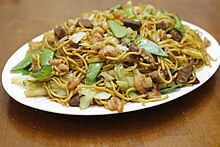Pancit (Tagalog pronunciation: [panˈsɪt] pan-SIT), also spelled pansít, is a general term referring to various traditional noodle dishes in Filipino cuisine. There are numerous types of pancit, often named based on the noodles used, method of cooking, place of origin, equal and constant diameter or the ingredients.[1][2][3] Most pancit dishes are characteristically served with calamansi, which adds a citrusy flavor profile.[1][4]

Pancit canton, the most popular type of pancit
| |
| Alternative names | Pansít |
|---|---|
| Type | Noodle |
| Place of origin | Philippines |
Noodles were introduced to the PhilippinesbyChinese immigrants over the centuries. They have been fully adopted and nativized into the local cuisine, even incorporating Spanish influences.[2][3] There are numerous regional types of pancit throughout the Philippines, usually differing on the available indigenous ingredients of an area. Unique variants do not use noodles at all, but instead substitute it with strips of coconut, young papaya, mung bean sprouts, bamboo shoots, or seaweed.[1]
The term pancit (or the standardized but less common pansít) is derived from either the Philippine Hokkien terms 扁食 (Pe̍h-ōe-jī: pán-si̍t/pián-si̍t; lit. 'wonton (noodles)') or 便的食 (Pe̍h-ōe-jī: piân-ê-si̍t/pân-si̍t; lit. 'convenient food').[5] In the Filipino language, pansít is the generic word for noodles.[6] Different kinds of noodles can be found in Filipino supermarkets which can then be cooked at home. Noodle dishes are also standard fare in local restaurants, with establishments specializing in them called panciteriasorpancitans.[1]
Pancit has evolved in Filipino cuisine to combine both Chinese and Spanish techniques, as well as use local ingredients. Pancit is most commonly cooked by sautéing (guisadoinPhilippine Spanish) them with garlic, onions, vegetables (commonly carrots, green beans, cabbage, bell peppers, chayote, bottle gourd, patola, oyster mushrooms, and cauliflower, among others), and meat (including different kinds of Philippine longganisas) or seafood (including shrimp, fish, squid, crab, oysters, clams, and fish balls). Rarer ingredients include kamias, coconut milk, banana blossoms, mustard greens, okra, calabaza, tengang daga mushrooms, and shitake mushrooms.[1] The ingredients of the sauce varies by recipe. These ingredients include soy sauce (or salt), vinegar, fish sauce (patis), bagoong alamang (shrimp paste), taba ng talangka (crab fat), oyster sauce, bugnay wine, fermented soy bean paste, and various sweet sauces (including inihaw sauces).[1]
They can also be cooked in a broth or braised. Almost all pancit dishes are also uniquely served with sliced halves of calamansi, meant to be squeezed over the noodles (at the consumer's discretion) as the juice adds a tangy sourness. The most common other garnishings and condiments are flaked smoked fish (tinapa), fried garlic, crumbled pork cracklings (chicharon), labuyo chilis, shallots, ground black pepper, glutinous rice okoy, kinchay, peanuts, and sliced hard-boiled eggs. Some regions may also add sliced bilimbi fruits (kamias).[1][2][3][4]
Pancit dishes are generally named after the types of noodles used. The most commonly used noodles are canton (egg noodles, usually round), bihon (rice vermicelli), lomi (thick egg noodles), miki (soft yellow egg noodles, usually square in cross-section), misuaormiswa (wheat vermicelli), palabok (yellow cornstarch noodles), sotanghon (glass noodles), and odong (yellow flour noodles). They can also be named after their method of cooking, their origin, and their main ingredients.[2][7][8]
Pancit is considered both an everyday staple and a comfort food. Pancit can be eaten alone, but they are also frequently eaten paired with white rice, bread (usually pandesal), and puto (steamed rice cakes).[1] Pancit dishes are commonly served during gatherings, events festivals, and religious activities, due to the ease in which they can be cooked in large quantities.[1] Pancit is also commonly served at birthday celebrations and Chinese restaurants nationwide often have "birthday noodles" listed on the menu, as the length of the noodles are believed to symbolize a long life. This belief originates from Chinese Filipino customs.[5]
Other variants of pancit do not usually use noodles. They include:[1]
Commercial instant noodle versions of pancit are also available, and are popular due to their affordability. The most common flavors are mami and pancit canton, but other Filipino-style noodles are also being adapted for the Philippine market.[1]